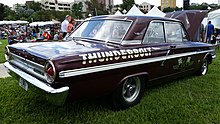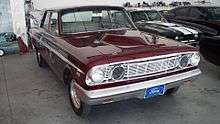Ford Fairlane Thunderbolt
The Ford Fairlane Thunderbolt is a limited production, factory experimental, drag racing version of the Ford Fairlane produced during the 1964 model year only. A total of 100 units were produced; forty-nine 4-speeds and fifty-one automatics, enough to secure the 1964 NHRA Super Stock championship for Ford.[1][2]
| Ford Fairlane Thunderbolt | |
|---|---|
.jpg) Ford Fairlane Thunderbolt | |
| Overview | |
| Manufacturer | Ford |
| Model years | 1964 |
| Assembly | United States: Dearborn, MI |
| Body and chassis | |
| Class | Muscle car |
| Body style |
|
| Layout | FR layout |
| Powertrain | |
| Engine |
|
| Transmission |
|
| Dimensions | |
| Wheelbase | 115.5 in (2,930 mm) |
| Length | 197.5 in (5,020 mm) |
| Width | 72.5 in (1,840 mm) |
| Curb weight | 3,203 lb (1,453 kg) |
Overview


Based on the standard two door post sedan Fairlane and named for a factory experimental Fairlane of 1963, the Thunderbolt combined the light weight of Ford's intermediate-sized body introduced in 1962 with a "high rise" 427 cu in (7.0 L) V8 engine with dual 4-barrel Holley carburetors intended for use in the much larger Galaxie. That engine as used in the Galaxie for NASCAR racing did well, but the Galaxie was simply too heavy an automobile in stock trim to be drag raced successfully; so-called "lightweight" 427-powered Galaxies were built both for stock car racing as well as drag racing during the 1964 model year, although these cars were not modified to the extent of the Thunderbolt.[3] As installed in the Thunderbolt, the engine was rated conservatively at 425 hp (431 PS; 317 kW) at 6,000 rpm and 480 lb⋅ft (651 N⋅m) at 3,700 rpm of torque;[4] estimates placed the actual output was close to 600 hp (608 PS; 447 kW).[5] [6] In standard form, the Fairlane is 12 in (305 mm) shorter than a Galaxie, rides on a 3.5 in (89 mm) shorter wheelbase and weighs approximately 700 lb (318 kg) less. Installing the Ford FE V8 in a vehicle intended for an engine no larger than a Ford Windsor/Challenger engine required major reworking and relocation of the car's front suspension components and the modification and strengthening of the suspension mounting areas. Fiberglass doors, hood, front fenders and even the front bumper on the earliest cars along with Plexiglas side and rear windows aided in weight reduction; the hood with its distinctive raised "teardrop" ram air scoop designed to draw hot air from the engine compartment was pinned in position, eliminating the need for a hood hinges and a latch. Later cars have aluminum front bumpers in place of the fiberglass units due to racing regulations.[7][8]
Racing equipment includes tubular exhaust headers, an electric fuel pump, altered rear suspension with heavy-duty traction control bars and asymmetrical leaf springs, trunk-mounted heavy duty battery, locking differential, auxiliary gauges, special drag race wheels and tires supplied both by Goodyear and Mickey Thompson (himself a recipient of one of the first ten cars) and an aluminum scatter shield designed to contain the clutch in case of disintegration under load. The claimed compression ratio was 13.5:1.[7][9]
Other weight-saving measures include the elimination of such street items as the sunvisors, radio, heater, wheel covers, passenger-side windshield wiper, arm rests, rear window cranks, mirrors, sound deadening material, carpeting, trunk mat, lug wrench, jack and spare tire. The front seats are either lightweight units from Ford's police package vehicles or rudimentary bucket seats from the Econoline van; the carpeting was replaced with a black rubber mat. The rear seat is a standard Fairlane unit. The high-beam headlights were eliminated as well and in their place are mesh-covered air intakes which run directly to a special air cleaner atop the 427. Like the street version, the Thunderbolt's outer high-low 5.75 in (146 mm) headlights of the type normally used with a four-lamp system are selectable with a standard foot-operated switch. Though it was technically a street-legal vehicle, these modifications and deletions along with a final drive ratio of 4:57.1 for the four-speed cars and 4:44.1 for the automatics make the Thunderbolt impractical for street use.
The Thunderbolt was not built on a regular Ford assembly line, but rather in conjunction with Andy Hotton of Dearborn Steel Tubing. It was there that partially built Fairlane bodies in top-of-the-line "500" exterior trim were combined with the 427 and either a heavy-duty Lincoln automatic transmission or a Borg-Warner four-speed manual transmission. The first eleven cars were painted in Ford's "vintage burgundy" while the remaining eighty-nine cars were painted "Wimbledon white." The engine code reflected not the 427 on most cars but rather the so-called solid lifter "K-code" 289 hi- performance engine. "427" emblems replaced the normal "260" or "289" emblems, and the "Fairlane 500" script on the upper front fenders was deleted. [10]
Given the special nature of the car, Ford riveted a metal plate to the inside of the glovebox door of the Thunderbolt and other race-only models with a disclaimer relating to fit and finish. The plate reads:
- This vehicle has been built specially as a lightweight competitive car and includes certain fiberglass and aluminium components. Because of the specialized purpose for which this car has been built and in order to achieve maximum weight reduction, normal quality standards of the Ford Motor Company in terms of exterior panel fit and surface appearance are not met on this vehicle.
Performance and motorsports
The Thunderbolt, as tested with a four-speed transmission at Lions Drag Strip in November 1963, ran a 1⁄4 mile (402 m) of 11.61 seconds at 124.8 mph (201 km/h).[13]
Thunderbolts faced off in the final of the 1964 NHRA Winternationals, driven by Butch Leal and Gas Ronda; Ronda took the win, with a pass of 11.78 seconds at 123.40 mph (198.59 km/h).[14] Ronda's Thunderbolt would go on to claim NHRA's national Top Stock crown that year.[15]
At the 1967 NHRA Winternationals, a factory Thunderbolt ran a 1⁄4 mile (402 m) of 10.365 seconds at 132.65 mph (213 km/h),[16] making it among the fastest–accelerating production cars over the quarter mile.
Media and merchandise
Miniatures of the Thunderbolt are currently manufactured by Hot Wheels and the Ertl Company.[17][18]
Revell makes a 1/25 scale plastic model kit of this car. Later releases include a stock hood and factory small dish hub caps in addition to the mag wheels and teardrop hood that were included in original releases.
The Ford Thunderbolt appears in the Xbox 360 game Forza Motorsport 4, mobile game CSR Classics and Forza Motorsport 7 for the Xbox One.
Gallery
 Interior of the car in the above photo with its Econoline bucket seats and later model Ford steering wheel and automatic transmission selector
Interior of the car in the above photo with its Econoline bucket seats and later model Ford steering wheel and automatic transmission selector Detail of the air intake setup and painted fiberglass bumper
Detail of the air intake setup and painted fiberglass bumper Underhood and outer air intake detail
Underhood and outer air intake detail Engine detail featuring the 427's unique dual-snorkel air intake
Engine detail featuring the 427's unique dual-snorkel air intake Rare fit and finish disclaimer plate riveted to the inside of the glovebox door
Rare fit and finish disclaimer plate riveted to the inside of the glovebox door
References
- Thunderbolt fansite at Angelfire.com
- "History of the Thunderbolt at Musclecarclub.com". Archived from the original on 2013-10-29. Retrieved 2010-04-04.
- http://www.carcraft.com/featuredvehicles/ccrp_0411_1964_ford_galaxie_500/index.html Feature on the 1964 Galaxie lightweight factory race car at Carcraft.com
- "1964 Ford Fairlane". myclassicgarage.com. Retrieved June 23, 2018.
- http://www.kitcarmag.com/thehistoryof/0411kc_ford_427_cammer/index.html
- http://www.holmanmoody.com/history.html
- Article on the 1964 Thunderbolt at Howstuffworks.com
- Richard Gunn (2006). Ultimate Performance Cars. MotorBooks International. pp. 130–131. ISBN 0-7603-2571-5.
- History of the Thunderbolt at Conceptcarz.com
- http://www.hotrod.com/featuredvehicles/hrdp_0911_ford_thunderbolt_reunion/index.html Article on the reunion of surviving Thunderbolts at Hotrod.com
- Reprint of January 2000 article in Hot Rod Magazine describing the disclaimer plate on a Thunderbolt used on a road tour
- "History of the lightweight 1964 Ford drag cars at 1964ford.com". Archived from the original on 2014-07-13. Retrieved 2010-04-12.
- http://www.hotrod.com/cars/featured/hrdp-0001-1964-ford-thunderbolt/ Thunderbolt specification chart from January 2000 at Hotrod.com
- Burgess, Phil, National Dragster editor. "Favorite Race Car Ever voting: Early Door Cars/Roadsters", written 11 July 2008, at NHRA.com (retrieved 27 September 2018)
- Waldron, Alex, National Dragster editor. "Gas Ronda", written 18 February 2016, at NHRA.com (retrieved 24 May 2017)
- http://www.draglist.com/draglist/search.php?GENDER%5B%5D=M&GENDER%5B%5D=F&FNAME=&LNAME=&CITY=&LIC=&FINISHNUMBER=&SORTBY=&ASCDESC=&VIEW=Extended&ENTRY=&OWNNAME=&OWNCITY=&CCNAME=&MODEL%5B%5D=Thunderbolt&ET=&ETTRK_DATE=&MPH=&MPHTRKDATE=&EMET=&EMETTRKDAT=&EMMPH=&EMMPHTRKDT=&TFET=&TFETTRKDAT=&TFMPH=&TFMPHTRKDAT=&ASPIRATION=&FUEL=&CID=&YR=&SHIFT=&PHOTOG=&NOTES=&SUBMITTER=&LASTUPDATER=&RACERWEBSITE=&PHOTOLINK=&search=Search Draglist
- Example of a Hot Wheels toy at Prestigehobbies.com
- "Example of a 1/18 replica at Diecastmodelswholesale.com". Archived from the original on 2011-07-10. Retrieved 2010-04-12.